2022 Spring Conferences Proceedings

|
Video Injection Attacks on Remote Digital Identity Verification Solution Using Face Recognition
Kévin Carta, Claude Barral, Nadia El Mrabet, Stéfane Mouille
Proceedings of the 13th International Multi-Conference on Complexity, Informatics and Cybernetics: IMCIC 2022, Vol. II, pp. 92-97 (2022); https://doi.org/10.54808/IMCIC2022.02.92
|
The 13th International Multi-Conference on Complexity, Informatics and Cybernetics: IMCIC 2022
Virtual Conference March 8 - 11, 2022 Proceedings of IMCIC 2022 ISSN: 2771-5914 (Print) ISBN (Volume II): 978-1-950492-61-9 (Print) |
|
Abstract
The COVID 19 pandemic has fuelled the acceleration of the use of remote services as, for example, video conferences or digital identity verification solutions. Due to videoconferences or social medias, attackers have access to rich biometric sources and therefore make it possible to carry out high quality attacks such as videos of deepfakes, or morphing, against face recognition system. These kind of video attacks allow the attacker to fool face recognition even when these systems are secured by challenge-based liveness detection by presenting them. In order to prevent against these kind of attacks, adding an artefact detection to these systems could be a good solution. However, we will see in this paper that the development of remote digital identity verification tools on mobile application or on a computer (through a web app) opens the path to video injection attacks which bypass all of these security systems, namely a face recognition system secured with both challenge-based liveness detection and artefact detection.
|
||




